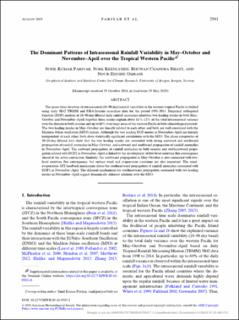The Dominant Patterns of Intraseasonal Rainfall Variability in May–October and November–April over the Tropical Western Pacific
Journal article
Published version

Åpne
Permanent lenke
https://hdl.handle.net/11250/2926273Utgivelsesdato
2019Metadata
Vis full innførselSamlinger
- Geophysical Institute [1198]
Originalversjon
Monthly Weather Review. 2019, 147 (8), 2941–2960. https://doi.org/10.1175/MWR-D-18-0383.1Sammendrag
The space–time structure of intraseasonal (10–90 day) rainfall variability in the western tropical Pacific is studied using daily 3B42 TRMM and ERA-Interim reanalysis data for the period 1998–2014. Empirical orthogonal function (EOF) analysis of 10–90-day filtered daily rainfall anomalies identifies two leading modes in both May–October and November–April; together these modes explain about 11%–12% of the total intraseasonal variance over the domain in both seasons and up to 60% over large areas of the western Pacific in both climatological periods. The two leading modes in May–October are linearly related to each other and both are well correlated with the Madden–Julian oscillation (MJO) indices. Although the two leading EOF modes in November–April are linearly independent of each other, both show statistically significant correlations with the MJO. The phase composites of 30–80-day filtered data show that the two leading modes are associated with strong eastward and northward propagation of rainfall anomalies in May–October, and eastward and southward propagation of rainfall anomalies in November–April. The eastward propagation of rainfall anomalies in both seasons and southeastward propagation related with EOF2 in November–April is linked to the development of low-level moisture flux convergence ahead of the active convection. Similarly, the northward propagation in May–October is also connected with low-level moisture flux convergence, but surface wind and evaporation variations are also important. The wind–evaporation–SST feedback mechanism drives the southeastward propagation of rainfall anomalies associated with EOF1 in November–April. The different mechanisms for southeastward propagation associated with two leading modes in November–April suggest dynamically different relations with the MJO.